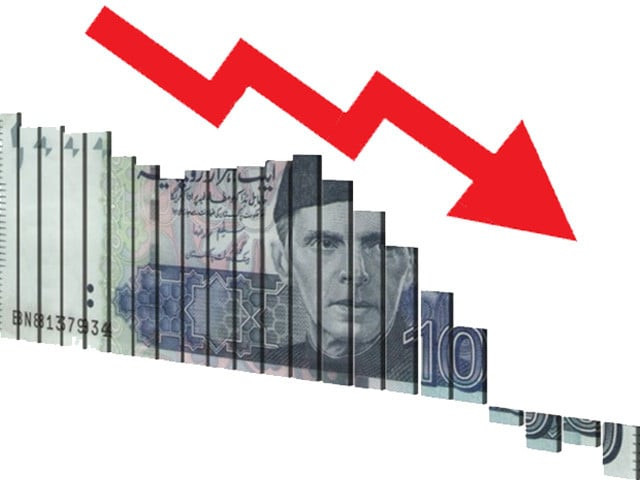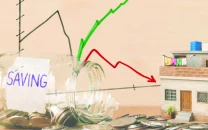Sometimes good economic news is bad
Dwindling deficit, while encouraging, may also reflect an economy that is losing momentum

Some recent numbers on Pakistan’s economy are seemingly showing promise. Yet, this phase of the economy carries a paradox; what appears as good news might also spell trouble. It’s crucial for policymakers to avoid the temptation of focusing solely on favourable data.
A significant economic figure showcasing improvement is the current account deficit, a key metric that shows the difference between dollar inflows (mainly through exports and remittances) and outflows (mainly as imports).
Recent data released by the State Bank shows a notable positive shift, registering a modest deficit of merely $8 million for September. Dollar inflows totalled approximately $5.49 billion while outflows amounted to $5.50 billion.
Observing the trend from the start of this fiscal year, there’s a visible trajectory of deficit reduction; from $775 million in July, to $164 million in August, and further down to $8 million in September.
The reported total deficit of $947 million for the three months is also lower compared to the $2.2 billion deficit reported during the same period of last year. On the surface, these figures hint at a pathway leading towards a current account surplus.
That being said, the dwindling deficit, while encouraging, may also reflect an economy that is gradually losing momentum. A positive indication could have been the decrease in the current account deficit driven by an upsurge in exports. Such a scenario would suggest a favourable trend, with exporters channelling dollars back into the economy.
However, the reality presents a different picture, as the exports have actually tapered off. In the previous three months, total exports for goods and services fell 4.1% from last year, amounting to $8.72 billion.
This suggests that the dip in the current account deficit is likely fuelled by a marked reduction in imports. A closer inspection reveals that the imports plummeted 19% to $14.9 billion in the Jul-Sept period. This downturn could largely be attributed to the weakening economic activity, which in turn lowers the demand for goods and services, resulting in reduced imports.
The economy evidently stands on shaky ground at this juncture.
Firstly, addressing the dip in imports is crucial. The decline in imports is a neutral phenomenon on its own, but it is certainly not a good sign when it is triggered by economic slowdown, factory shutdowns, layoffs, inflation, and high borrowing costs.
A positive dip in imports, on the other hand, is the one that is caused by a growth in import substitution. Although this hasn’t happened with Pakistan’s economy, it should be the target of policymakers.
The exorbitant import bill can be reduced, given that the country possesses abundant resources to curtail it.
Read Is the worst behind Pakistan’s economy?
Take, for instance, Pakistan’s oil refining sector. The country hosts five oil refineries, boasting a collective capacity of 20 million tonnes per annum, churning out petrol, diesel, and furnace oil. Despite its pivotal role, this sector hasn’t received much attention from the government in the past and is operating without a coherent policy or strategic roadmap for years on end.
Consequently, the industry runs at a meagre 50% to 60% of its potential, compelling Pakistan to import fuels, which unduly bloats the import bill.
On a brighter note, the government has recently rolled out an oil refinery policy focused on upgrading existing and constructing new refineries. However, this doesn’t address the immediate issue of underutilisation. There’s an urgent need to boost the operational capacity of these refineries to reduce import dependency. Policymakers must facilitate them to operate at full capacity.
This requires a joint effort from the government and the industry to draft a viable plan, with the financial sector’s involvement being the key to ensuring liquidity for efficient crude oil purchases.
Secondly, and perhaps more importantly, the sluggish growth of exports needs to be looked into. A robust and sustainable current account foundation can only be established through a consistent growth in exports.
It’s somewhat ironic that while certain import substitution industries have languished due to insufficient government support, an export-oriented sector that did receive policymakers’ backing hasn’t shown significant growth.
For years, the textile sector has been a major contributor to Pakistan’s export revenues and a beneficiary of government subsidies. This sector saw a 14% downturn in exports, which dwindled to $4 billion in the Jul-Sept period. Broadly, the exports of all goods retreated nearly 5% to $7 billion. Contrarily, the IT sector defied this downbeat trend. Without any major financial aid, the exports of IT and IT-enabled services advanced 3.3% to $655 million, showcasing a glimmer of resilience amid a challenging economic landscape.
The export trends offer key lessons for policymakers. The government’s support should be broad-based, encompassing a variety of sectors rather than favouring a singular industry. The untapped potential in overlooked industries, when nurtured, could significantly boost the country’s export growth.
A thorough analysis must be conducted to identify such industries, understand global demand dynamics, and accordingly align exports to meet this demand effectively.
To ensure a robust economy and a solid current account, addressing both weak exports and high imports is crucial.
Encouraging economic figures look promising on paper, yet one must avoid selective data interpretation to prevent a false sense of accomplishment. Policymakers should adopt a holistic view of the economy, encompassing all its facets, to chart a sustainable path forward.
The writer is a corporate consultant specialising in business and economic issues
Published in The Express Tribune, November 13th, 2023.
Like Business on Facebook, follow @TribuneBiz on Twitter to stay informed and join in the conversation.


















COMMENTS
Comments are moderated and generally will be posted if they are on-topic and not abusive.
For more information, please see our Comments FAQ